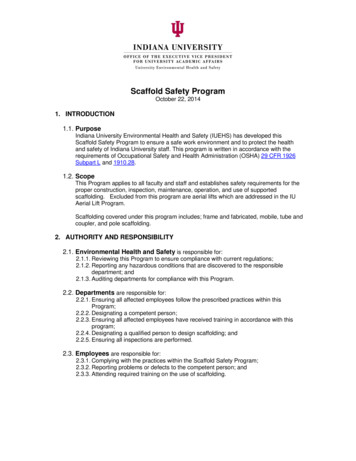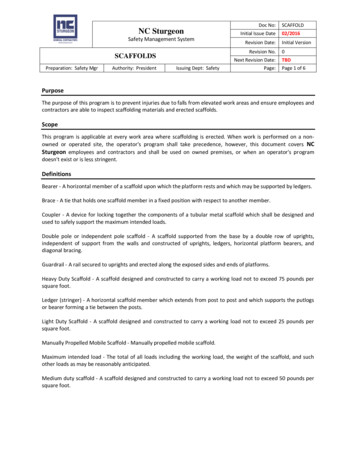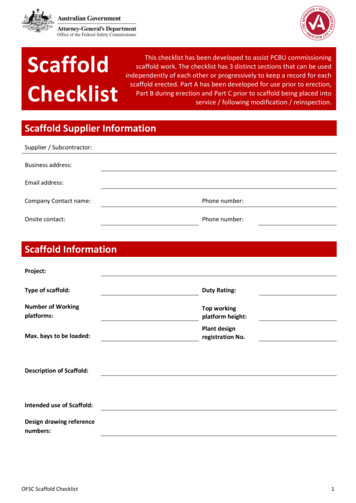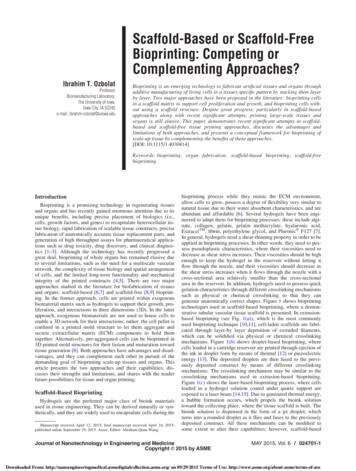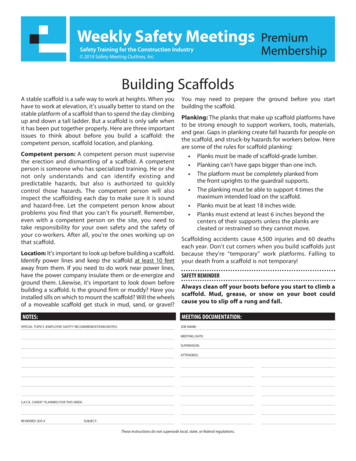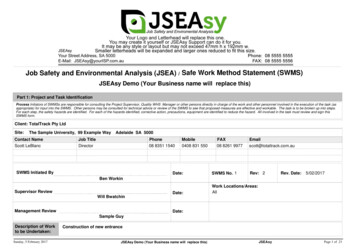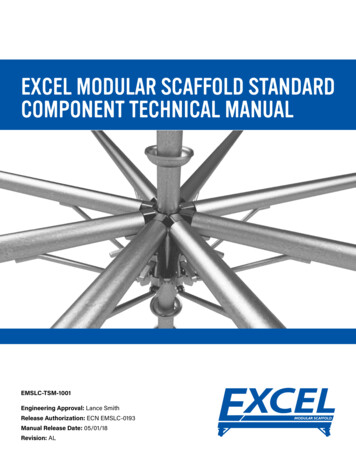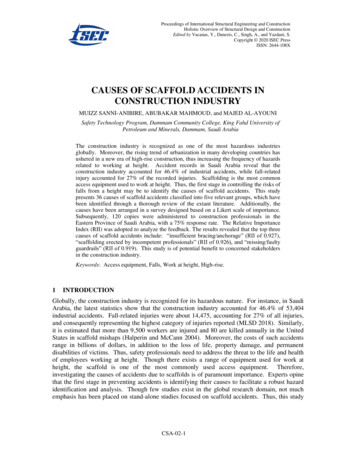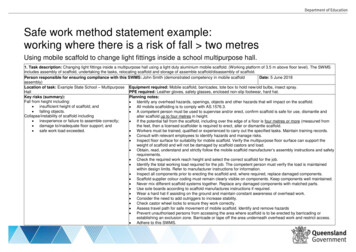
Transcription
Safe work method statement example:working where there is a risk of fall two metresUsing mobile scaffold to change light fittings inside a school multipurpose hall.1. Task description: Changing light fittings inside a multipurpose hall using a light duty aluminium mobile scaffold. (Working platform of 3.5 m above floor level). The SWMSincludes assembly of scaffold, undertaking the tasks, relocating scaffold and storage of assemble scaffold/disassembly of scaffold.Person responsible for ensuring compliance with this SWMS: John Smith (demonstrated competency in mobile scaffoldDate: 5 June 2018assembly)Location of task: Example State School – Multipurpose Equipment required: Mobile scaffold, barricades, tote box to hold new/old bulbs, insect spray.PPE required: Leather gloves, safety glasses, enclosed non-slip footwear, hard hat.HallKey risks (summary):Planning notes:Fall from height including: Identify any overhead hazards, openings, objects and other hazards that will impact on the scaffold. insufficient height of scaffold; and All mobile scaffolding is to comply with AS.1576.3. falling objects. A competent person must be used to supervise and/or erect, confirm scaffold is safe for use, dismantle andCollapse/instability of scaffold includingalter scaffold up to four metres in height. inexperience or failure to assemble correctly; If the potential fall from the scaffold, including over the edge of a floor is four metres or more (measured from damage to/inadequate floor support; andthe feet, then a licensed scaffolder is required to erect, alter or dismantle scaffold. safe work load exceeded. Workers must be trained, qualified or experienced to carry out the specified tasks. Maintain training records. Consult with relevant employees to identify hazards and manage risks. Inspect floor surface for suitability for mobile scaffold. Verify the multipurpose floor surface can support theweight of scaffold and will not be damaged by scaffold castors and load. Obtain, read, understand and strictly follow the mobile scaffold manufacturer’s assembly instructions and safetyrequirements. Check the required work reach height and select the correct scaffold for the job. Identify the total working load required for the job. The competent person must verify the load is maintainedwithin design limits. Refer to manufacturer instructions for information. Inspect all components prior to erecting the scaffold and, where required, replace damaged components. Scaffold supplier colour coding must remain clearly visible on components. Keep components well maintained. Never mix different scaffold systems together. Replace any damaged components with matched parts. Use sole boards according to scaffold manufactures instructions if required. Wear a hard hat if assisting on the ground and maintain constant awareness of overhead work. Consider the need to add outriggers to increase stability. Check castor wheel locks to ensure they work correctly. Assess travel path for safe movement of mobile scaffold. Identify and remove hazards Prevent unauthorised persons from accessing the area where scaffold is to be erected by barricading orestablishing an exclusion zone. Barricade or tape off the area underneath overhead work and restrict access. Adhere to this SWMS.
Manual handlingUnidentified/unexpected site specific hazards Responsible person: John SmithCarry out as much preparation work on the ground as possible before accessing heights.Provide safe means of raising, lowering and storing tools, plant, materials and rubbish.Discuss site specific mandatory safe work practices with all workers undertaking the task.Identify additional hazards and implement safety controls where required. Two workers are to independently verify that power to light circuits has been turned off at switchboard. Select correct replacement light bulbs/tubes. Use insulated tools if light covers/protection need to be removed Do not assemble scaffold near overhead electrical hazards. Maintain an exclusion zone of at least fivemetres.Residual risk level: low to medium1. Procedure3. How will the hazards and risks be controlled?Electric shock or electrocution including electrical safety is not maintained; power is not isolated prior to work.2. What are the hazards or risks youhave identified?a) erect baseframes andbracing Failure to assemble according to manufacturer’s instructions. Unsupported frames I – frames fall over striking person erecting scaffoldor other person close to the work area. Sprains, strains, bruises, pinch/crush, fatigue from moving heavy/awkward objects.Incorrectly assembled first framescausing unstable scaffold base. b) erect second level frames and bracing Fall from scaffold during erection.Climbing lightweight scaffold baseframes during erection.Scaffold tips over causing fall.Base frames not sufficiently bracedor supported.Instability/collapse of base framescausing fall. 4. Who is5. What isresponsible fortheimplementing and residualmonitoring theserisk level?controls?John SmithMediumAssembly must occur under guidance of competent person.Barricade work area to prevent unauthorised access.Make sure manufacturer assembly instructions are provided and are easyto read (e.g. print large enough, clear photocopy).Provide a suitable number of staff to lift and assemble scaffold safely.Use bracing or team member/s to support first frames.Lay parts out and identify components to minimise double handling.Use mechanical aid (e.g. trolley or pallet jack to move scaffoldcomponents).Make sure colour coding referred to in instructions are clearly visible on all John Smithcomponents.Do not assemble the base frame upside down as castor wheels will not fitcorrectly.Adjust castor wheels correctly to level the base frames.Two workers to cross-check castor wheels are adjusted correctly and inthe locked position.John SmithNever climb up the outside of the frame as this will cause scaffold to tipsideways.Use a suitable number of workers to complete assembly safely.Make sure the foundation is level and suitable for mobile scaffold.John SmithFollow assembly instructions to make sure no bracing is left out, fixedincorrectly or incorrectly positioned. This will avoid scaffold distorting out ofsquare due to lack of diagonal bracing.Check castor wheels are locked to prevent movement.MediumMediumMedium
c) erect workplatform, edgeprotection,ladder and toeboards Climbing on lightweight scaffoldbase frames.Scaffold moves suddenly or tipsover causing fall. d) completescaffolderection Uneven or split decks installedonto second frames.Step/trip on split deck or stepbackward off higher deck duringassembly causing fall from height.Edge protection incomplete.Fall from unprotected workingplatform. Ladder access hatch not closed ortrapdoor missing resulting in a fallthrough ladder access hatch.Incorrect access to workingplatform (e.g. climbing up or downthe outside of the scaffold, noladder access) causing falls whilstaccessing work platform.Sprains, strains, pinch/crush orfractures.Scaffold erected without followingmanufacturer’s specifications.Scaffold incomplete.Scaffold topples over causing afall from height.Unauthorised removal of orinterference with scaffoldcomponents. Incorporate plan bracing at the base of mobile scaffolds to providegreater stability.Never climb the external walls of the scaffold – this may cause it to tip.Use more than one person for frame erection to eliminate the need toclimb up and down the frame.Castor wheels must be locked to prevent movement while the edgeprotection is installed.Use a second worker to stabilise scaffold.Make sure there is enough staff available to help with lifting materials tohigher levels.Check and confirm that all components of the deck platforms areinstalled and set at the same height to ensure the entire work platform islevel and there are no gaps or missing pieces.John Smith andteam memberMediumJohn SmithLowFollow manufacturer’s instructions for handrail assembly (position 9001100mm above the working platform on all sides. Install mid rail and toeboard on all sides).Castor wheels must be locked to prevent movement whilst edgeprotection is installed.Close hatch when working on deckInstall the ladder inside the scaffold frame according to manufacturer’sinstructions.Secure the ladder at the top and the bottom.Make sure the ladder accesses the work platform through a trapdoor.Do not hang the ladder vertically off the handrail or ledger on theexternal or internal face of the scaffold.John SmithMediumJohn SmithMediumMake sure there is enough staff available to safely lift platforms ontosecond level frames.The height of the scaffold work platform does not exceed the height tobase width ratio defined in AS4576.The general height of light duty aluminium mobile scaffold must notexceed three times the minimum base dimension e.g. base dimensionsof 2.4 m x 1.8 m the height to the working platform should be no morethan 5.4m.For a scaffold with a narrow base width of less than 1.2 m, the height ofthe light duty mobile scaffold must not exceed twice the base width e.g.a scaffold with a base of 2.4 m x 1.2 m, the height to the workingplatform should be no more than 2.4m.Scaffold must be inspected by competent person prior to use.John SmithMediumJohn SmithLow
e) use scaffold f) change lightbulb/lightfittings Unauthorised removal of orinterference with scaffoldcomponents.Scaffold incomplete.Step backward off work platform,split deck platform uneven or notlevel or over reach outside workplatform causing fall from height.Scaffold struck by mobile plant orequipment or by students usinghall causing injury due to scaffoldcollapseHigh risk work or unauthorisedwork completed outside of scopeof SWMSWorking below overhead workSlips, trips and falls Hit by falling objects Electric shock burns orelectrocution.Manual handling – working abovethe headCuts from broken glassInsect bites and stings Make sure an isolation process is available for incomplete scaffolds, e.g.danger tag or warning signs ready to be put in place.Immediately report any incident/near miss which either did or could havecaused serious injury.Competent person must inspect scaffold prior to use. Record pre-startinspection on Mobile Scaffold Pre-start Checklist.Tag out the scaffold if it is unsafe for use.Check scaffold regularly to ensure it always remains level and plumb.All other plant and equipment is to remain outside an establishedexclusion zone.Protect the base of scaffold from impact or interference e.g.balls/students.Manage the exclusion zone and support worker on scaffold by using a‘spotter’.Only work approved in this SWMS may be undertaken on the scaffold.Only authorised workers are to enter the barricaded or taped off areawhile overhead work is being carried out.Wear enclosed non-slip footwear, hard hats and maintain constantawareness of overhead work when working inside the in the barricadedarea.Keep work platform and ground level work area clear of obstructions.Make sure appropriate equipment is used to raise and lower objects,including making sure that load limits are not exceeded.Never climb on guard rails, use a ladder on the work platform or useother objects to increase your reach height on the work platform.Time work for periods when student/teacher foot traffic is absent.Secure all tools and/or equipment by lanyard or store in a toolbox/basketwhen on the work platform.Toe boards must be fitted to the working platform.An exclusion zone must be established around scaffold (e.g. barricadeor bunting) to protect workers below.Inspect the work area for electrical and overhead hazards.Visually inspect fittings for insects and other hazards before touching.Make sure the work platform is set at correct height to reach job. Keepyour body inside the work platform at all times.Do not overstretch to reach the lights. You must relocate scaffold.Keep the working platform free of rubbish, tools and equipment.John SmithMediumWorker usingscaffold andchanging bulbsLowWorkers on thegroundMediumWorker usingscaffold andchanging bulbsLow
g) movescaffold to anew location. Dust and debris in eyes Use insect spray to control spiders/wasps when required.Wear safety glasses to protect eyes from falling debris. Scaffold topples over.Objects falling from work platform Inspect travel path for hazards. Control hazards before movingscaffold.Follow planned travel path – maintain prescribed distance fromoverhead hazards and avoid openings, penetrations or unprotectededges. Make sure scaffold component do not strike overheadfixtures.Time work for when student/teacher/visitor foot traffic is absent.Never move scaffold with persons on it. All workers must descendfrom scaffold before repositioning.Never grasp overhead objects or walls to pull scaffold along.Never locate scaffold too close to an exposed edge (e.g. stage) orprotruding feature or position scaffold on pit doors, trapdoors or flooraccess panels.Lower and secure outriggers/stabilisers where fitted and lock castorsbefore accessing the scaffold.Turn light circuits back on at switchboard.Clean and maintain scaffold components to reduce force required whenassembling/disassembling. Inspect and replace damaged componentsto minimise the risk of equipment failure. Record all maintenance in thescaffold maintenance register.Recycle old light bulbs/tubes according to DoE’s Disposal of EnergyEfficient Lighting Tubes and BulbsAvoid leaving scaffold unattended in work area. Barricade access ifrequired.Store scaffold securely when assembled to prevent unauthorised access(e.g. a designated storage area secured from unauthorised access).Lock castor wheels.John SmithLowPrincipalLowAn unlicensed person must not alter scaffolding without authority from alicensed, competent personMake sure there is an isolation system for incomplete scaffold (e.g.danger tag or warning signs).Always make sure there are sufficient workers to complete task safely.Never access incomplete or defective scaffolds.John SmithLow h) clean upsite Manual handling i) securescaffold j) dismantleand/or alterscaffold Scaffold left unattended andunsecured.Scaffold accessed byinexperienced personScaffold falls onto person orobject.Scaffold accessed or interferedwith by unauthorised personsFall from scaffold.Scaffold incomplete or partlydismantledUnauthorised removal of orinterference with scaffoldcomponents.Manual handling injuries –heavy/awkward objects, fatigue
Unstable or incorrect dismantlingof scaffold.Inappropriate alterations toscaffold.Injury due to scaffold collapse.Falling object. Make sure workers have sufficient experience or skills and knowledge tocomplete the required task. Make sure instructions provided can be easily read and accuratelyfollowed. Never drop scaffold components from height during dismantling. Wear a hard hat when dismantling scaffold. Wear close fitting leathergloves that do not restrict movements if required.Designation: Health and Safety Advisor/Schools OfficerJohn SmithPrepared by:Review date: 5/05/2018Signature:John SmithThis SWMS has been developed in consultation with and has been read, understood and signed by all workers undertaking the tasks described:Print namesSignaturesDatesJohn Smith10/06/18Bruce Melman10/06/18Jack Rhodes11/06/18Approved by: Sarah TallbridgeSignature:Required resources:Mobile scaffold manufacturer’s instructionsMobile scaffold pre-start inspection checklistScaffold maintenance registerReferences:Managing the risk of falls at a workplace Code of Practice 2018Scaffolding Code of Practice 2009 Mobile Scaffold (s6.1, 6.2 and7.1.3).AS4576 AS/NZS 4576-1995 Guidelines for scaffolding.AS/NZS1576: Part 1: Scaffolding – General Requirements.Position: Principal, Example State High SchoolDate: 11/06/18Low
Mobile scaffold pre-start checklist – INDOOR USE.Use this checklist to control the planning, erection, alteration and dismantling of a scaffold to ensure the important safetyfeatures and procedures are in place. Modify the checklist to include local site conditions and scaffold manufacturerrecommendations where required. Tick yes or no against each item. ‘Yes’ indicates compliance with regulatory or code ofpractice requirements. ‘No’ answers will need to be addressed to ensure that you comply with requirements.Yes NoPrior to erectionAre manufacturer’s or supplier’s instructions available? Required under s7.1.3Scaffold COP 2009CommentCopy of light duty aluminium scaffold modelLDSM001 available.Is the fall height less than four metres? If the answer is NO, (i.e. fall height ofor more) certificated scaffolders are required. WHS Regulation 2011 s225(1)Are competent people available to erect, alter or dismantle scaffold?Working platform height 3.5 mHas adequate training been provided for workers for erecting scaffolds under4m? Required under s2.2 Scaffold COP 2009Is the supporting floor surface hard and flat?John Smith trained Bruce Melman and JackRhodes. John will supervise assembly. Trainingrecords on file.Are there sufficient staff to complete the job safely?3 staff. John Smith will superviseWhere site specific risks are identified, have controls been put in place:Inspection of work area undertaken during SWMSdevelopment. Inspection on day prior to erection ofscaffold to check no additional hazards present. adequacy of supporting surface? travel path for mobile scaffold? distances to overhead electrical hazards? proximity to openings, edges or protrusions? protection from moving plant, objects, tampering, unauthorised access? protection of staff, students and visitors? electrical safetyHave safe work method statements that incorporate fall prevention for thepeople erecting, altering and dismantling of the scaffold been prepared, readand understood by workers?During erectionIs incomplete scaffolding access blocked with a physical barrier as well assignage?Are scaffolds erected a safe distance away from unprotected edges e.g.stages or stairwells or protruding structures?Are sufficient staff available to complete work safely?On completionScaffold assembly complies with manufacturer’s instructions. Provisions forrecorded inspections of scaffold are used prior to work starting, before use ofthe scaffold is resumed after an incident occurs and after repairs; and at leastevery 30 days (on advice from supplier) to verify it is safe to access and use.Any unauthorised improvisations to the scaffold have been eliminated.John Smith. Training records on file.SWMS statement read, signed and understood byall workers. Workers familiar with scaffold assemblyinstructions and procedureHall has been closed off for the day to eliminatepedestrian traffic3 staffInspected and verified ready to go by John SmithScaffold must be tagged out until repairs are made- WHS Regulation 225(5).Are the castor wheel locks in working order? They should be locked at all times,except during movement of the scaffold.Is the tower level, plumb and stable? slope of the surface should not exceed 5degrees (s7.1.3 Scaffold COP 2009).Sole boards properly distribute the load if used to protect the floor surface?Have all braces been installed according to instructions?Is ladder access available to every platform level? Is ladder supplied andfitted internally? All mobile scaffold over 2m must have ladder fitted. (AS1576).Are toe boards fitted to all working decks and all access/egress decks?Not requiredEdge protection is required on open sides & ends of platforms over 2m. AS1576Are work platforms entire, and in good, clean condition (eg split, cracked orgaps) AS1576 (split decks are illegal); s5.7 Scaffold COP 2009. Any platform missingshould be barricaded and rectified. WHS Regulation 225Are mid rails and guardrails installed to all platform levels? All scaffolds shouldhave these rails regardless of height.Are signs for duties placed on platforms? (“Light duty 225 kg”). This allowsworkers to instantly recognise how much weight can be safely supported by each bay (AS1576), s5.3.2 Scaffold COP 2009If the scaffold is unattended or stored (but not disassembled), are appropriatesafety measures to prevent unauthorised access observed?Hall doors to be locked when scaffold unattended.Store padlocked in hall cage area when jobcompleted.
interference with scaffold components. a scaffold with a base of 2.4 m x 1.2 m, the height to the working The height of the scaffold work platform does not exceed the height to base width ratio defined in AS4576. The general height of light duty aluminium mobile scaffold must not exceed three times the minimum base dimension e.g. base dimensions
